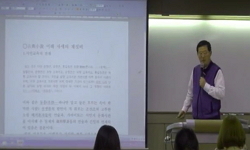The modern Arab writers had to write their literary works only in Modern Standard Arabic owing to various reasons such as political, social, practical, and cultural reasons. But after appearance of the realistic literature, they have been facing the ...
http://chineseinput.net/에서 pinyin(병음)방식으로 중국어를 변환할 수 있습니다.
변환된 중국어를 복사하여 사용하시면 됩니다.
- 中文 을 입력하시려면 zhongwen을 입력하시고 space를누르시면됩니다.
- 北京 을 입력하시려면 beijing을 입력하시고 space를 누르시면 됩니다.
https://www.riss.kr/link?id=A105785526
- 저자
- 발행기관
- 학술지명
- 권호사항
-
발행연도
2012
-
작성언어
-
-
주제어
Modern Standard Arabic ; Colloquial Arabic ; conversation ; novel ; the Insertion Test ; the Dictionary Test ; Nagib Mahfuz ; 현대표준아랍어 ; 방언 ; 대화 ; 소설 ; 삽입 검증 ; 사전 검증 ; 나깁 마흐푸즈
-
KDC
790
-
등재정보
KCI등재
-
자료형태
학술저널
-
수록면
23-45(23쪽)
-
KCI 피인용횟수
1
- DOI식별코드
- 제공처
-
0
상세조회 -
0
다운로드
부가정보
다국어 초록 (Multilingual Abstract)
The modern Arab writers had to write their literary works only in Modern Standard Arabic owing to various reasons such as political, social, practical, and cultural reasons. But after appearance of the realistic literature, they have been facing the problem whether or not they would use Ammiyah in their literary activities especially in the dialogue part. There is no doubt that the dialogue written in Modern Standard Arabic not in Colloquial Arabic tends to decrease the sense of livelihood and realism. Therefore some Arab novelists tried to write down conversational expressions in seemingly Modern Standard Arabic but actually Colloquial Arabic in order to maximize the literary efficiency. This study examined the subject by dividing the main study into 3 chapters; the style of the colloquial expression, hybridization, and the borrowed expressions. And this study also tried to prove the colloquial expressions by applying the Insertion Test and the Dictionary Test. It is interesting to note that the writers such as Nagib Mahfuz in Egypt used the Arabic dialect in his literary works even though he is well known for criticizing the use of Colloquial Arabic in the written texts.
참고문헌 (Reference)
1 Al-Khanajīri, Wafā’, "al-Amthāl al-Sha`biyyah fi Hayātina al-Yawmiyyah" Tanta 186-, 1982
2 Cachia, P.J.E, "The use of the colloquial in Modern Standard Arabic Literature" 87 : 12-22, 1967
3 Saīd, Nafusa Zakariyya, "Tarīkh al-Da`wa ila al-`Ammiyya wa-Atharuha fī Misr" Alexandria 1964
4 Yāqūt, "Mu`jam al-Udabā’, In Margoliouth 2nd ed" 238-, 1929
5 Somekh, Sasson, "Lughat al-Qissa fī `Adab Yūsuf Idrīs" Tel-Aviv and Acre 27-62, 1984
6 Somekh, Sasson, "Language and Thema in the Short Stories of Yūsuf Idris" 7 : 89-100, 1975
7 Somekh, Sasson, "Genre and Language in Modern Arabic Literature, Chapter 3" Wiesbaden 1991
8 Issawi, Charles, "European loan words in Arabic Writing: A case study in modernization" 3 : 110-133, 1972
9 Duwāra, Fu’ād, "Ashrat Udaba Yatahaddathun" Cairo 286-287, 1965
10 Mitchel, F.M., "An Introduction to Egyptian Colloquial Arabic" Oxford 104-105, 1956
1 Al-Khanajīri, Wafā’, "al-Amthāl al-Sha`biyyah fi Hayātina al-Yawmiyyah" Tanta 186-, 1982
2 Cachia, P.J.E, "The use of the colloquial in Modern Standard Arabic Literature" 87 : 12-22, 1967
3 Saīd, Nafusa Zakariyya, "Tarīkh al-Da`wa ila al-`Ammiyya wa-Atharuha fī Misr" Alexandria 1964
4 Yāqūt, "Mu`jam al-Udabā’, In Margoliouth 2nd ed" 238-, 1929
5 Somekh, Sasson, "Lughat al-Qissa fī `Adab Yūsuf Idrīs" Tel-Aviv and Acre 27-62, 1984
6 Somekh, Sasson, "Language and Thema in the Short Stories of Yūsuf Idris" 7 : 89-100, 1975
7 Somekh, Sasson, "Genre and Language in Modern Arabic Literature, Chapter 3" Wiesbaden 1991
8 Issawi, Charles, "European loan words in Arabic Writing: A case study in modernization" 3 : 110-133, 1972
9 Duwāra, Fu’ād, "Ashrat Udaba Yatahaddathun" Cairo 286-287, 1965
10 Mitchel, F.M., "An Introduction to Egyptian Colloquial Arabic" Oxford 104-105, 1956
11 Farūk, `Umar, "Al-Qawmiyya al-Fushā" Beirut 1961
12 Wright, W., "A Grammar of the Arabic Language, 3rd ed" University Press 2-, 1991
13 Wehr, Hans, "A Dictionary of Modern Written Arabic, 3rd ed" Librairie du Liban 1974
14 Badawī, El-Sa`īd, "A Dictionary of Egyptian Arabic" Librairie du Liban 1986
동일학술지(권/호) 다른 논문
-
A Study on the Binding Condition of the Pronouns in Arabic
- 한국아랍어아랍문학회
- ( Jin Young Choi )
- 2012
- KCI등재
-
"사원에 자주 모이는 바쓰라 사람들의 이야기"에 나타난 풍자
- 한국아랍어아랍문학회
- 학회자료
- 2012
- KCI등재
-
- 한국아랍어아랍문학회
- ( Lama Ramadan )
- 2012
- KCI등재
-
Stylistic and Theatre Question is a stylistic feature of the theater
- 한국아랍어아랍문학회
- 학회자료
- 2012
- KCI등재
분석정보
인용정보 인용지수 설명보기
학술지 이력
| 연월일 | 이력구분 | 이력상세 | 등재구분 |
|---|---|---|---|
| 2026 | 평가예정 | 재인증평가 신청대상 (재인증) | |
| 2020-01-01 | 평가 | 등재학술지 유지 (재인증) |  |
| 2017-01-01 | 평가 | 등재학술지 유지 (계속평가) |  |
| 2013-01-01 | 평가 | 등재 1차 FAIL (등재유지) |  |
| 2010-01-01 | 평가 | 등재학술지 유지 (등재유지) |  |
| 2007-01-01 | 평가 | 등재학술지 선정 (등재후보2차) |  |
| 2006-01-01 | 평가 | 등재후보 1차 PASS (등재후보1차) |  |
| 2004-07-01 | 평가 | 등재후보학술지 선정 (신규평가) |  |
학술지 인용정보
| 기준연도 | WOS-KCI 통합IF(2년) | KCIF(2년) | KCIF(3년) |
|---|---|---|---|
| 2016 | 0.13 | 0.13 | 0.12 |
| KCIF(4년) | KCIF(5년) | 중심성지수(3년) | 즉시성지수 |
| 0.1 | 0.1 | 0.402 | 0.1 |




 KCI
KCI 스콜라
스콜라






